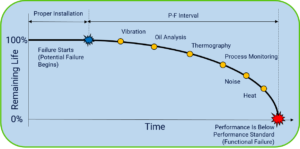Understanding The Importance of Proper Equipment Installation
 There has been much discussion (and often debate) around the P-F curve. The P-F curve illustrates the relationship between the warning signs that are detectable by various technology or methods and the progression of the failure. What is often not discussed and overlooked, is what happens before the equipment starts to deteriorate.
There has been much discussion (and often debate) around the P-F curve. The P-F curve illustrates the relationship between the warning signs that are detectable by various technology or methods and the progression of the failure. What is often not discussed and overlooked, is what happens before the equipment starts to deteriorate.
If the ultimate goal of an organization is to be proactive and ensure equipment uptime, wouldn’t the organization want to prevent the equipment from failing in the first place and not catch it after it has already started to fail?
Proper equipment installation is absolutely critical to ensuring the long-term, problem-free operation of an asset. Proper installation is much higher up on the P-F curve, where the curve is still flat before a defect occurs. By focusing on this flat section of the P-F curve, any organization can be proactive from the very beginning.
How To Ensure Proper Equipment Installation
So how does an organization ensure proper installation? There is a methodology that is to ensure proper equipment installation and prevent defects from occurring.
- Establish standards for equipment installation. These standards set forth all of the requirements for equipment and components installation. These standards are broken down by component, include the how, as well as the specification which must be achieved.
- Have equipment installed to the standard. The standards must be communicated with procurement, engineering, and maintenance. The standards must provide as part of the contract if using external staff. This will ensure that the manufacturers of the equipment will build and install the equipment to the standard. The internal team needs to be trained on the standards as well.
- Validate that the standards have been met. Providing the standards to the manufacturer or installer is not enough. The installation needs to be validated that the standards have been achieved. This could be done by having the installer document all activities and performing physical spot checks to ensure that the documents match what is found.
- Check that the standards are still achieved. Three to six months after the equipment is installed, go back and validate that all of the components installed are still within the acceptable standard. This will ensure that after the break-in period that the equipment/components have not drifted out of standard and potentially lead to defects.
This approach needs to be documented in the various process(es), policies and procedures used by the organization for CAPEX, Procurement, and Maintenance.
What Standards Are Required?
With the methodology defined, standards need to be defined for each type of equipment or component. A generic standard that states “All equipment/components will be installed to manufacturer recommendations or known best practices.” is not acceptable. These standards need to be detailed and take into account all of the various sizes and usage of the equipment/component. Listed below are some of the common installation standards that should be included in any program;
- Foundation – How large should the foundation be? What should the foundation be made of?
- Alignment – Have all couplings been aligned to acceptable offset and angular tolerances? Are the tolerances based on the RPM of the coupling… they should be.
- Balancing – At what speeds should the rotor be balanced at? Will it be balanced on a single plane or multiplane? What ISO grade is required for the various levels of equipment criticality?
- Vibration – What level of vibration is acceptable and where on the equipment is it acceptable, if at all?
- Anchoring – What size and type of anchors bolts are acceptable. Will J-Bolts be used, wedge type anchors, threaded rod with epoxy or chemical anchors?
- Isolation – Will isolation be achieved by separating the foundation from the surrounding floor? Or will springs and elastomeric pads be used?
- Level – Is liquid level enough, or should a laser system be used to ensure a true horizontal plane?
- Bearings – All bearing should be installed using an immersion heater and oil bath.
This is just a sample of a few of the standards that may be required. All of the standards need to be detailed in their expectations and final outcomes. As always, choose and develop the standards that make sense for your organization. Not all organizations may require standards for everything, so be pragmatic about it.
Equipment installation is no longer a simple activity that just involves tightening bolts before start-up. There are many standards (ASTM, ANSI, ASME, etc.) that provide best practices for all aspect. The question is, is your equipment installation adequate to prevent failures in the first place?
Remember, to find success; you must first solve the problem, then achieve the implementation of the solution, and finally sustain winning results.
I’m James Kovacevic
Eruditio, LLC
Where Education Meets Application
Follow @EruditioLLC
References:

